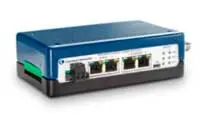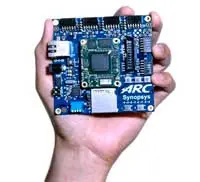Electronics News
Archive : 15 September 2016 год
 A narrowband radio providing reliable and secure data transmission over long distances has been launched by Cambium Networks. Aimed at Industrial Internet of Things (IIoT) applications, the radio – called cnReach – is said to allow operators to manage their IIoT network deployments effectively.
A narrowband radio providing reliable and secure data transmission over long distances has been launched by Cambium Networks. Aimed at Industrial Internet of Things (IIoT) applications, the radio – called cnReach – is said to allow operators to manage their IIoT network deployments effectively.
Bruce Collins, product manager, said: “The radio is aimed at such sectors as oil and gas, utilities and smart transportation. It’s an outdoor product, rather than for use in factories.”
The product, which supports licensed and unlicensed operation at 900MHz and 700MHz, is intended to help users transition from serial networks to all-IP networks. “It’s about connecting process control information,” Collins explained. “These users are risk averse, which means things like security and reliability are key factors.”
Users can deploy cnReach in point to point and point to multipoint configurations, as well as in a relay. “It all depends on the terrain,” Collins said. “It offers longer range: anything from hundreds of metres to maybe 100km.”
As most applications for the radio will involve control and monitoring, data rate is not critical. “That will vary from 100kbit/s to 4.5Mbit/s,” Collins said, “but the key is the ability to relay data over long distances.”
Although targeting the US at first, Cambium is planning follow on products operating at 100, 200 and 400MHz. “As these are added,” said Collins, “global opportunities will follow.”
Author
Graham Pitcher
Source: www.newelectronics.co.uk
 As the Internet of Things develops, security is becoming increasingly important, particularly for so called edge devices. Typically, these have been MCU based and vulnerable to attacks.
As the Internet of Things develops, security is becoming increasingly important, particularly for so called edge devices. Typically, these have been MCU based and vulnerable to attacks.
Looking to address the problem, Synopsys has launched the DesignWare ARC SEM110 and SEM120D security processors, said by the company to protect systems against software, hardware and side channel attacks, as allowing designers to separate secure and non secure functions as part of a Trusted Execution Environment (TEE).
Angela Raucher, ARC EM product line manager, said: “Because a lot of companies designing IoT edge nodes are concerned about power, performance and area (PPA), they want to run cryptography in software, rather than hardware, so the device needs to be protected. However, security can’t be solved at the expense of PPA because developers want to provide long battery life.
“Threats can be seen at the network, chip and device levels and the key to the solution is to put in more layers of protection.”
The SEM processor cores are based on the 32bit ARCv2 instruction set architecture (ISA) and optimised for area and power efficiency. The SEM110 integrates a range of security technologies and can be implemented in an SoC as either a standalone secure core or as a single core performing secure and non-secure functions. The SEM120D adds DSP functionality, catering for applications such as sensor processing and voice identification in health care and IoT devices.
Key features of the devices include: resistance to side channel attacks; an enhanced memory protection unit, a tamper resistant pipeline with
instruction and data encryption, as well as address scrambling; and a watchdog timer to detect system failures, including tampering.
Raucher added: “The cores also include error correction functionality, which will detect fault injection techniques.”
Author
Graham Pitcher
Source: www.newelectronics.co.uk
 The UK’s National Physical Laboratory (NPL) has developed a new, non-destructive, method of measuring the three dimensional orientation of molecules in an organic semiconductor transistor, using Raman spectroscopy. This technique will help to create a new, faster and more flexible method of measuring the efficiency of electrical conductivity in a printed circuit.
The UK’s National Physical Laboratory (NPL) has developed a new, non-destructive, method of measuring the three dimensional orientation of molecules in an organic semiconductor transistor, using Raman spectroscopy. This technique will help to create a new, faster and more flexible method of measuring the efficiency of electrical conductivity in a printed circuit.
Modern electronic devices are able to save significant cost and weight by using organic (as opposed to in-organic) semi-conductors as they allow large-volume printing of electronic circuits onto thin sheets of plastic material. The ‘ink’ used in such devices, such as LEDs or solar cells, consists of organic polymer molecules that conduct electricity. As this ‘ink’ dries, however, molecules can crystallise in all directions, making it harder for electrons to travel along it, so reducing its ability to conduct electricity. Measuring the direction of molecules in a printed circuit is a key part of the quality control process.
Until now, measuring such variations non-destructively and in three dimensions has not been possible. This new method for doing so takes advantage of how a molecule vibrates when light is shone on it. Different vibrations change the frequency of the reflected light, the main principle behind Raman spectroscopy. Molecules facing different directions will react – or vibrate – differently as a laser is passed over, causing reflected light of different frequencies. By measuring the different light frequencies reflected by the printed circuit, NPL’s test reveals the orientation of the molecules in the circuit in three dimensions.
By creating such a test for printed electronic circuits, the efficiency of the production process of electronic devices can be drastically increased, meaning they can be made cheaper, faster and of better quality.
NPL Higher Research Scientist Dr Sebastian Wood says, “Understanding molecular orientation has been an area of interest to the printed electronics community for over a decade, with various one and two dimensional tests being undertaken. NPL is the first organisation to characterise this important property efficiently and in three dimensions, without destroying the test circuit. We’re excited to be the organisation that enables what could be a revolutionary breakthrough in the performance and commercial viability of printable electronics.”
Author
Neil Tyler
Source: www.newelectronics.co.uk

